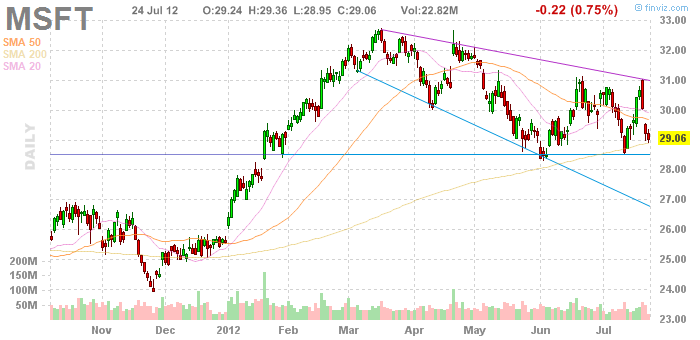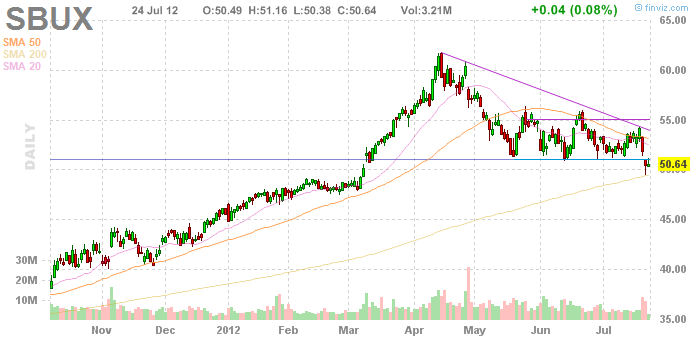Would you be on the other side of these trades: MSFT & SBUX?
In today’s volatile market, being long and neutral in your portfolio can deliver returns in uncertain markets. Today, I will present two options strategies, one conservative and one speculative, and then ask WSO if you would be on the other side of these trades.
I will propose a covered call on Microsoft (MSFT) and a bull call spread on Starbucks (SBUX).
Microsoft
On the conservative end, covered calls are used to place a neutral bet on a stock by buying an underlying stock and then selling an out-of-the-money (OTM) call option. This strategy can be used to lock in gains or enhance returns in a flat market.
Microsoft reported Q2 earnings last week which were roughly in-line (outside of extraordinary events). The earnings were mostly a non-story as traditional businesses (Windows, server & enterprise, Bing, Xbox) have been performing as expected. Investors are unlikely to move the stock greatly due to the anticipation of Windows 8 which will be released in October. The options market has been pricing in a lower trading band for the stock as implied volatility has been subdued below historical volatility and the greatest volumes have been more concentrated after earnings.
You can buy MSFT stock and then recycle AUG, SEP, and OCT short call options each month that are 8-10% out of the money. You would be able to collect MSFT’s dividend in August and be paid to wait for the next two and a half months before Windows 8 is launched. Potential profit is in the neighborhood of 25% with little downside risk if your position is fully hedged.

On the speculative side, we can use multiple call options (long and short) to make a debit spread that will be profitable if a stock preforms well while hedging losses. For example if a stock is trading at 10, we can buy a $12 strike call and sell a $20 strike call. We will make money if the underlying trades above $12 + premium paid. However, gains are limited because we sold a $20 call. If the stock does not increase in value, we will make money from the $20 call option that we sold short.
Starbucks (SBUX) reports earnings later this week and while analyst expectations are pretty high, investor sentiment has significantly deteriorated recently due to macro headwinds. The stock is down 20% from is 52 week high and is down 10% in the last month ahead of earnings.
The fundamental case for SBUX is that it is a growth machine internationally and domestically. Internationally, its stores are located in over 50 countries where it achieves higher margins -but a majority (2/3) of its stores are located in the US. SBUX is aggressively expanding in China where it is tripling its store count. Domestically, the company is leveraging a very popular mobile app platform to drive sales as customers receive incentives and deals to buy drinks. SBUX has also started a very popular “gold card” program which has helped expand a group of hard-core regular SBUX drinkers.
The stock has sold off for two primary reasons: China and European macro concerns. We have already seen other similar companies such as Yum report in-line China expectations. Furthermore, SBUX is very highly regarded in China and is a strong play on the rising wage trends there. On the European concern front, if you take a look at SBUX locations by country (Link), you would actually see that its stores are not concentrated in the PIGS countries and are strongly positioned in Germany and France. There are by far more Starbucks located in developing countries compared to Europe.
Currency risk is a major issue and could damper international results. However, I believe that SBUX's domestic same store sales growth should surprise to the upside and mitigate loss from currency factors. Ultimately, I think investors got a little too nervous and over sold the stock before earnings.
SBUX is currently trading around $50. To establish a call spread, we can buy the AUG $52.5 call and selling the AUG $57.5 call. The trade should cost about $0.50 to make (the net of the premiums sold and bought). The optimal profit scenario would be if the company reports strong earnings and pushes the stock to $57 because you would be able to keep your call premium and also make money from your long call. This trade has potential upside of around 100% and potential downside of around 50% (it depends on your execution prices and commissions).

DISCLOSURE: I am currently long SBUX



Probably a stupid question, but I'm a little confused by your statement on the MSFT trade:
"You can buy MSFT stock and then recycle AUG, SEP, and OCT short call options each month that are 8-10% out of the money. You would be able to collect MSFT’s dividend in August and be paid to wait for the next two and a half months before Windows 8 is launched. Potential profit is in the neighborhood of 25% with little downside risk if your position is fully hedged."
I am by no means an experienced trader and without doing much digging into MSFT, I like the idea. I'm just not sure I understand your statement above.
accountingbyday, your assumption for 1. is correct. To short a call means to be the writer of the call. I would like to echo your question as to how one would fully hedge the downside. My only thoughts are buying a put w/ a strike price at some support level but that would turn it into a collar and reduce the potential profit.
Interesting SBUX pitch though. Looks like some price consolidation in the chart and volatility plays such as straddles/strangles might be another option. Although increased implied volatility from upcoming earnings reports may dampen profits, one does not have to be correct about direction to profit.
+1 SB
Thanks Mark, that's exactly what I assumed I had just never heard of writing a call being called "short".
I think both are interesting trades. With AAPL missing today, MSFT might be brought down as well, making the MSFT trade potentially more appealing.
Mark is correct in that when I said short call, I meant to write call options. Typically in a covered-call scenario, you write 1 call for every 100 shares of stock that you own; however, there are several variations that you can use to spice things up. If you want to fully hedge your position and firmly lock in your upside and downside, then you can make the trade "delta neutral" where you match the delta of the stocks with the delta of the options. There are new risks and rewards depending on how hedged you ultimately make the trade.
If you would like to learn about covered calls, this is a pretty good tutorial: http://www.optiontradingpedia.com/free_covered_call.htm And if you would like to learn more about delta hedging: http://www.optiontradingpedia.com/delta_neutral_trading.htm
There are other ways to make a market-neutral play on a stock, but covered calls are fairly simple and effective and let you capture dividends (MSFT is yielding over 2.5%).
A rise in implied vol could indeed damper profitability. You could always write a couple less options than you sold. Though it's probably a good idea to hedge an earnings bet because it is more or less a gamble.
I actually simplified my actual trade a bit in the analysis. I bought AUG calls and then equally wrote calls against the position between AUG and SEP calls. In this way, I am limiting my near term risk of a spike in IV and also get to take advantage of theta decay on the different calendar dates.
Whoever sold me my AAPL puts last week is FUCKED.
One problem I see is that your figures are a bit off. MSFT is trading for around 29. The August 32 call has a bid of about $0.03 or $3 per every 100 shares or about one-tenth of one percent (not annualized) before commissions. You maintain the downside to MSFT, so this is not what I would call a conservative strategy.
If you wanted to do something that was 'market neutral' you would need to delta hedge continuously and the option would need mispriced for it to work out. No matter what you did, the commissions in this scenario would eat you alive.
Blanditiis cumque voluptatum ipsum totam omnis. Non voluptate aut eos alias sint. Necessitatibus inventore quia quam eum aliquid ut praesentium.
Voluptatibus qui nostrum nulla pariatur repellat. Sunt rerum cumque accusantium ex delectus. Aliquid ducimus molestias assumenda dignissimos tempora non et.
See All Comments - 100% Free
WSO depends on everyone being able to pitch in when they know something. Unlock with your email and get bonus: 6 financial modeling lessons free ($199 value)
or Unlock with your social account...